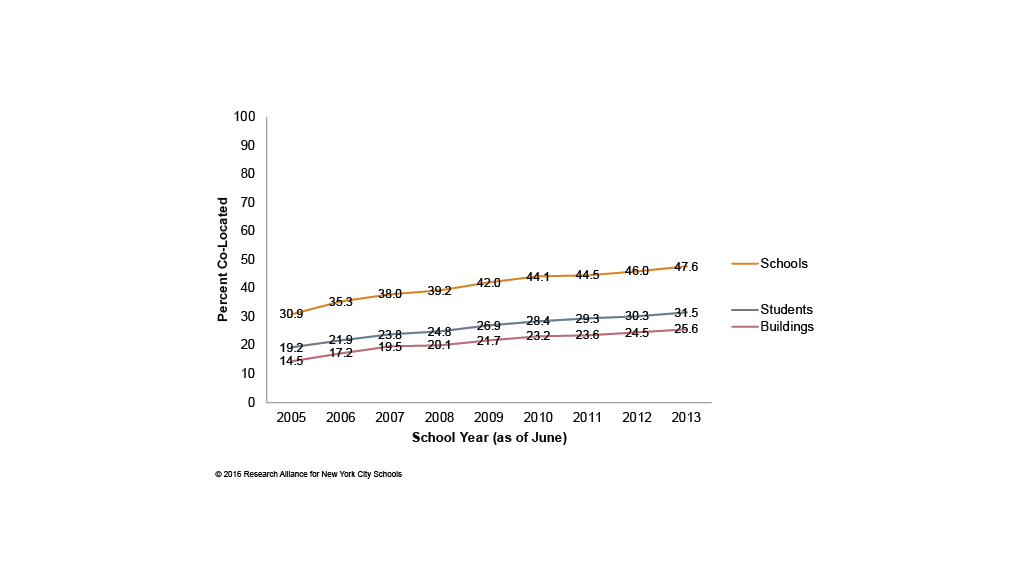The practice of school co-location—when multiple schools are housed within a single building—has generated considerable controversy in New York City. Under the previous administration, policies that emphasized closing persistently low-performing schools (and in many cases, replacing them with a number of smaller schools in a single building) as well as the growth of charter schools contributed to a rise in co-locations. The graph below shows the growth of school co-locations between 2005 and 2013.[1]
Percent of NYC Students, Schools, and Buildings Co-Located, 2005-2013

In 2005, 19 percent of the City’s students attended school in a building housing more than one school. By 2013, this had risen to 32 percent—more than 300,000 students.[2] In that same year, NYC’s 1,748 schools were spread across 1,232 buildings. Around half of all NYC public schools shared a building with another school, compared to 31 percent in 2005.
Key Stats (2012-2013 School Year)
- NYC has a total of 1,748 schools.
- 832 schools (47.6%) are co-located
- 330,741 students (31.5%) attend co-located schools.
- This translates to a 64% increase over 2005, when 201,047 students attended co-located schools.
While co-locations increased in every borough, the most substantial changes occurred in Brooklyn, which also has more schools than any other borough.[3] The percentage of Brooklyn schools that are co-located nearly doubled, from 27 percent in 2005 to 49 percent in 2013. In Manhattan and the Bronx, co-location was already a common practice in 2005 (over 40 of schools), and increased more slowly.
Co-locations also became more prominent across grade configurations.[4] In 2005, most co-located schools in NYC were high schools. In recent years, though, elementary schools have become co-located at a much faster rate than other grade configurations—in 2005, 11 percent of elementary schools were co-located, which grew to 31 percent by 2013. This likely relates to the growing number of charter schools in the City (most of which are elementary schools).
Indeed, there are more than six times as many charter schools in New York City today as there were in 2005. While in 2005 charters accounted for only 2 percent of City schools, by 2013 they accounted for 11 percent. The percentage of charters that are co-located has also grown. In 2005, 26 percent of charter schools were co-located; by 2013, almost 60 percent were co-located. For comparison, in 2005, 31 percent of district schools were co-located; by 2013, 46 percent of district schools were co-located.
Big Questions
There has been widespread public debate about co-locations. Challenges—including limited resources for individual schools, and negative effects on students and staff—have been widely reported and the subject of lawsuits. Yet some co-locations have been celebrated as success stories. More research is needed to understand the landscape of co-locations in the City. Important questions include:
- Are some groups of students or communities (e.g., defined by neighborhood, socio-economic status, race) more likely to be served by co-located schools? Are some groups of students or communities more likely to actively oppose co-locations, either before or after they are enacted?
- How do factors like grade configurations and whether schools are charters affect the operation and effectiveness of co-located schools?
- What conditions and practices facilitate opportunities for co-located schools to learn from each other and build off one another’s strengths?
The NYC Department of Education has recently explored the strategy of merging schools (sometimes co-located, sometimes not), in an effort to promote efficient use of school resources and expand the reach of strong leaders. However, co-locations are a pervasive part of City’s current school system. Future research should explore whether there are certain conditions that increase the odds of co-locations being equitable and successful.
What other questions should we be asking? Are you exploring any of these topics? Let us know via email.
This post was developed using data provided to the Research Alliance for New York City Schools by the NYC Department of Education. Analyses conducted by Suzanne Wulach and James Kemple.
Footnotes
[1] We have excluded home schools, evening schools, Community Based Organization (CBO) pre-schools, Young Adult Borough Centers (YABCs), GED centers, prison schools, hospital schools, schools with fewer than 15 students enrolled, and schools about which building information is not known.
[2] Note that the number of students in the NYC school system remained relatively constant over this period, between 1 million and 1.1 million.
[3] Not shown in graph.
[4] Not shown in graph.
How to Cite this Spotlight
Wulach, S., Kemple, J. 2016. "Trends in School Co-Locations in NYC" Spotlight on NYC Schools. Research Alliance for New York City Schools.

